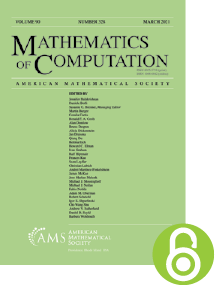On the conjecture of Hardy & Littlewood concerning the number of primes of the form $n^{2}+a$
HTML articles powered by AMS MathViewer
- by Daniel Shanks PDF
- Math. Comp. 14 (1960), 321-332 Request permission
References
- G. H. Hardy and J. E. Littlewood, Some problems of ‘Partitio numerorum’; III: On the expression of a number as a sum of primes, Acta Math. 44 (1923), no. 1, 1–70. MR 1555183, DOI 10.1007/BF02403921 A. E. Western, “Note on the number of primes of the form ${n^2} + 1$,” Cambridge Phil. Soc., Proc., v. 21, 1922, p. 108-109.
- Daniel Shanks, A sieve method for factoring numbers of the form $n^{2}+1$, Math. Tables Aids Comput. 13 (1959), 78–86. MR 105784, DOI 10.1090/S0025-5718-1959-0105784-2
- Daniel Shanks, Quadratic residues and the distribution of primes, Math. Tables Aids Comput. 13 (1959), 272–284. MR 108470, DOI 10.1090/S0025-5718-1959-0108470-8 Daniel Shanks, “On the conjecture of Hardy and Littlewood concerning the number of primes of the form ${n^2} + a$,” Notices, Amer. Math. Soc., v. 6, 1959, p. 417. Abstract 559-52. The numbers b(s) also arise in an entirely different connection—they are related to the number of distinct circular parity switches of order s. See Daniel Shanks, “A circular parity switch and applications to number theory,” Notices, Amer. Math. Soc., v. 5, 1958, p. 96. Abstract 543-7. It was in this connection that the author first noted the unusual proof of a special case of the Fermat “little” theorem—see (9a) above. Likewise it was in this connection that Bernard Elpsas, in a private communication to the author (Sept. 3, 1958), developed the formula (9). E. Landau, Aus der elementaren Zahlentheorie, Chelsea, 1946, Part IV, Chap. 6-9. Fletcher, Miller & Rosenhead, Index of Mathematical Tables, McGraw-Hill, 1946, p. 42, 43, p. 63. The correspondence between our notation and theirs is as follows: ${L_1}(s) = {u_n}$, ${L_2}(s) = {p_n}$, ${L_{ - 2}}(s) = {q_n}$, ${L_3}(s) = {h_n}$, and ${L_{ - 3}}(s) = {t_n}$. A similar sieve argument was given for the twin prime problem in Charles S. Sutton, “An investigation of the average distribution of twin prime numbers,” Jn. Math. Phys., v. 16, 1937, p. 1-42.
- G. H. Hardy and E. M. Wright, An introduction to the theory of numbers, Oxford, at the Clarendon Press, 1954. 3rd ed. MR 0067125
- Ernst Trost, Primzahlen, Verlag Birkhäuser, Basel-Stuttgart, 1953 (German). MR 0058630
- Atle Selberg, The general sieve-method and its place in prime number theory, Proceedings of the International Congress of Mathematicians, Cambridge, Mass., 1950, vol. 1, Amer. Math. Soc., Providence, R.I., 1952, pp. 286–292. MR 0044563
Additional Information
- © Copyright 1960 American Mathematical Society
- Journal: Math. Comp. 14 (1960), 321-332
- MSC: Primary 10.00
- DOI: https://doi.org/10.1090/S0025-5718-1960-0120203-6
- MathSciNet review: 0120203


